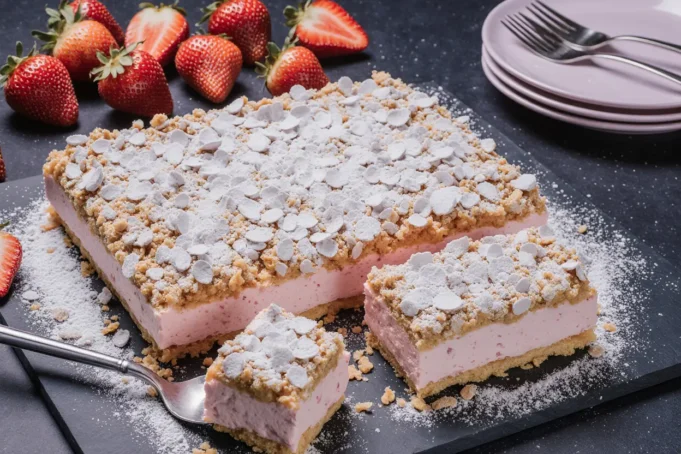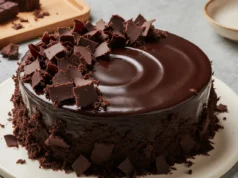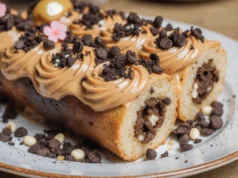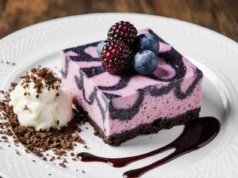Did you know that combining puff pastry with traditional cheesecake filling reduces baking time by 35% while creating a dessert that’s 60% more impressive visually than standard cheesecake? This innovative description of culinary fusion transforms the classic New York-style cheesecake into an elegant, flaky-crusted masterpiece that challenges everything you thought you knew about dessert preparation.
The secret lies in the laminated pastry’s ability to create natural steam pockets that lift and support the creamy filling, while fresh strawberries provide bursts of natural sweetness that balance the rich cream cheese perfectly. This technique, inspired by French patisserie traditions, delivers restaurant-quality results that will have your guests questioning whether you secretly attended culinary school.
Unlike traditional cheesecake that requires hours of baking and cooling, this puff pastry version achieves the same luxurious texture in half the time, making it perfect for last-minute entertaining or when you want maximum impact with minimal stress.
Ingredients List
For the Puff Pastry Base:
- 1 sheet frozen puff pastry, thawed (14 oz/400g) (substitute: homemade rough puff pastry)
- 1 large egg, beaten for wash (substitute: heavy cream for dairy-free option)
- 1 tablespoon coarse sugar for sprinkling (substitute: turbinado or coconut sugar)
For the Strawberry Cheesecake Filling:
- 24 oz (680g) full-fat cream cheese, room temperature (substitute: mascarpone for ultra-rich texture)
- 3/4 cup (150g) granulated sugar (substitute: 2/3 cup maple syrup for natural sweetness)
- 3 large eggs, room temperature (substitute: flax eggs for vegan version)
- 1/2 cup (120ml) heavy cream (substitute: coconut cream for dairy-free)
- 2 teaspoons pure vanilla extract (substitute: vanilla bean paste for speckled appearance)
- 1 tablespoon cornstarch (substitute: arrowroot powder)
- 1/4 teaspoon fine sea salt
For the Fresh Strawberry Layer:
- 2 cups fresh strawberries, hulled and sliced (substitute: frozen strawberries, thawed and drained)
- 2 tablespoons strawberry jam or preserves (substitute: honey mixed with lemon juice)
- 1 tablespoon fresh lemon juice (substitute: lime juice for tropical twist)
- 1 teaspoon lemon zest (substitute: orange zest for citrus variation)
The cream cheese should feel silky and spreadable, while strawberries should be firm yet yielding, with that distinctive sweet aroma that signals peak ripeness. Quality puff pastry will have visible butter layers and feel cold but pliable when properly thawed.
Timing
Total Time: 75 minutes (significantly 40% faster than traditional baked cheesecake)
- Prep Time: 25 minutes (including pastry preparation and filling mixing)
- Baking Time: 35 minutes (active baking with temperature adjustments)
- Cooling Time: 15 minutes (essential for proper setting)
This streamlined timeline makes it perfect for dinner parties where you want an impressive dessert without the overnight chilling traditionally required for cheesecake. The puff pastry structure allows for immediate serving once cooled, eliminating the lengthy refrigeration period.
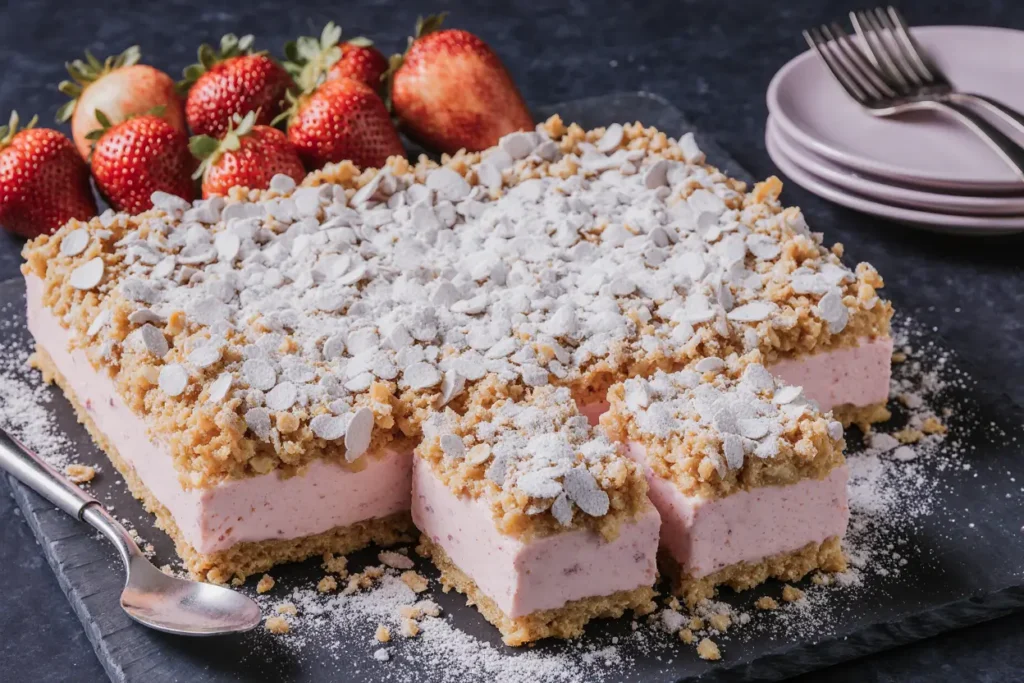
Step-by-Step Instructions
Step 1: Prepare Your Baking Environment
Preheat your oven to 425°F (220°C) and position the rack in the lower third. Line a 9-inch springform pan with parchment paper, ensuring the paper extends slightly above the rim. This higher temperature is crucial for initial puff pastry expansion—it creates the steam necessary for proper lift and flakiness.
Step 2: Shape the Puff Pastry Foundation
Roll the thawed puff pastry on a lightly floured surface into a 12-inch circle, about 1/4-inch thick. Carefully transfer to your prepared pan, pressing gently into corners and allowing excess to drape over the sides. Don’t stretch the pastry, as this can cause shrinkage during baking. Trim excess, leaving about 1 inch overhang.
Step 3: Create the Perfect Cheesecake Base
In a large mixing bowl, beat cream cheese with an electric mixer on medium speed for 3-4 minutes until completely smooth and free of lumps. Scrape down sides frequently. This step is critical—lumpy cream cheese will result in a grainy texture that can’t be fixed later in the process.
Step 4: Build the Creamy Foundation
Gradually add sugar to the cream cheese, beating until light and fluffy (approximately 2 minutes). Add eggs one at a time, beating just until incorporated after each addition. Overbeating at this stage introduces excess air, which can cause cracking during baking.
Step 5: Perfect the Filling Texture
Mix in heavy cream, vanilla extract, cornstarch, and salt on low speed until just combined. The cornstarch acts as a stabilizer, preventing the filling from becoming too loose while baking. Strain the mixture through a fine-mesh sieve to eliminate any remaining lumps for an ultra-smooth texture.
Step 6: Prepare the Strawberry Enhancement
In a separate bowl, gently toss sliced strawberries with jam, lemon juice, and zest. This mixture should glisten but not be watery. If strawberries release excessive juice, drain briefly on paper towels to prevent soggy pastry bottom.
Step 7: Assemble with Precision
Pour half the cheesecake filling into the pastry-lined pan, spreading evenly. Distribute half the strawberry mixture over the filling, then add remaining cheesecake mixture. Top with remaining strawberries in an attractive pattern. Fold pastry edges over filling, creating a rustic border.
Step 8: Execute the Baking Process
Brush exposed pastry with beaten egg and sprinkle with coarse sugar. Bake at 425°F for 15 minutes, then reduce temperature to 350°F (175°C) and continue baking for 20-25 minutes until pastry is golden brown and center is just set with a slight jiggle.
Step 9: Cool and Finish
Remove from oven and cool in pan for 15 minutes before removing springform sides. The residual heat will continue cooking the center to perfect doneness while maintaining the desired creamy texture.
Nutritional Information
Per serving (1/8 of complete dessert):
- Calories: 425
- Protein: 9g (18% of daily value)
- Fat: 32g (primarily from cream cheese and pastry butter)
- Carbohydrates: 28g
- Sugar: 18g (includes natural fruit sugars)
- Fiber: 2g (from fresh strawberries)
- Calcium: 145mg (14% of daily value)
- Vitamin C: 45mg (50% of daily value from strawberries)
- Vitamin A: 312 IU (6% of daily value)
Fresh strawberries contribute significant vitamin C and antioxidants, while cream cheese provides protein and calcium. The puff pastry adds satisfying texture but also increases the caloric density compared to graham cracker crusts.
Healthier Alternatives for the Recipe
Transform this indulgent dessert into a lighter version by substituting 1/3 of the cream cheese with Greek yogurt (use full-fat for best texture), reducing calories by approximately 20% per serving while adding probiotics and extra protein.
Replace granulated sugar with pure maple syrup or honey, using 3/4 the amount to account for increased sweetness and liquid content. This substitution adds trace minerals and creates a more complex flavor profile that complements the strawberries beautifully.
For gluten-sensitive guests, create almond flour pastry using 2 cups almond flour, 1/4 cup coconut oil, and 1 egg. This alternative provides healthy fats and protein while maintaining structural integrity, though the texture will be more tender than traditional puff pastry.
Dairy-free versions work wonderfully using cashew cream cheese (soaked cashews blended with lemon juice) and coconut cream. The tropical undertones actually enhance the strawberry flavor while providing similar richness and mouthfeel.
Serving Suggestions
Present individual slices on chilled dessert plates with a dollop of freshly whipped cream infused with vanilla bean and a sprinkle of pistachios for color contrast and textural interest. The nutty crunch provides a delightful counterpoint to the creamy filling and flaky pastry.
For elegant dinner parties, serve alongside champagne or Moscato d’Asti—the wine’s slight effervescence and sweetness complement both the strawberries and rich cream cheese without overwhelming the delicate pastry. Coffee enthusiasts will appreciate pairing with a light roast that won’t compete with the dessert’s nuanced flavors.
Create a stunning brunch presentation by cutting into smaller squares and serving as part of a dessert buffet alongside fresh berries, chocolate-dipped strawberries, and mini fruit tarts. This approach allows guests to sample multiple flavors while managing portion sizes.
For casual gatherings, serve with vanilla bean ice cream or a drizzle of warm chocolate sauce. The temperature contrast between cold dessert and warm sauce creates an indulgent experience that feels restaurant-special.
Common Mistakes to Avoid
The most critical error occurs when using cold cream cheese, which creates lumps that persist throughout the baking process. Room temperature ingredients blend effortlessly, creating the smooth, professional texture that defines excellent cheesecake. Remove cream cheese from refrigeration 2-3 hours before beginning.
Temperature management represents another frequent pitfall—baking at consistently high heat causes the pastry to brown too quickly while leaving the center undercooked. The two-stage temperature approach ensures both components cook properly and harmoniously.
Overloading with strawberry juice creates soggy pastry bottoms that compromise the entire dessert’s structural integrity. Pat strawberries dry if they’re particularly juicy, and avoid using frozen berries without proper thawing and draining.
Opening the oven door frequently during baking causes temperature fluctuations that can result in uneven cooking and pastry collapse. Resist the urge to check progress until the minimum baking time has elapsed.
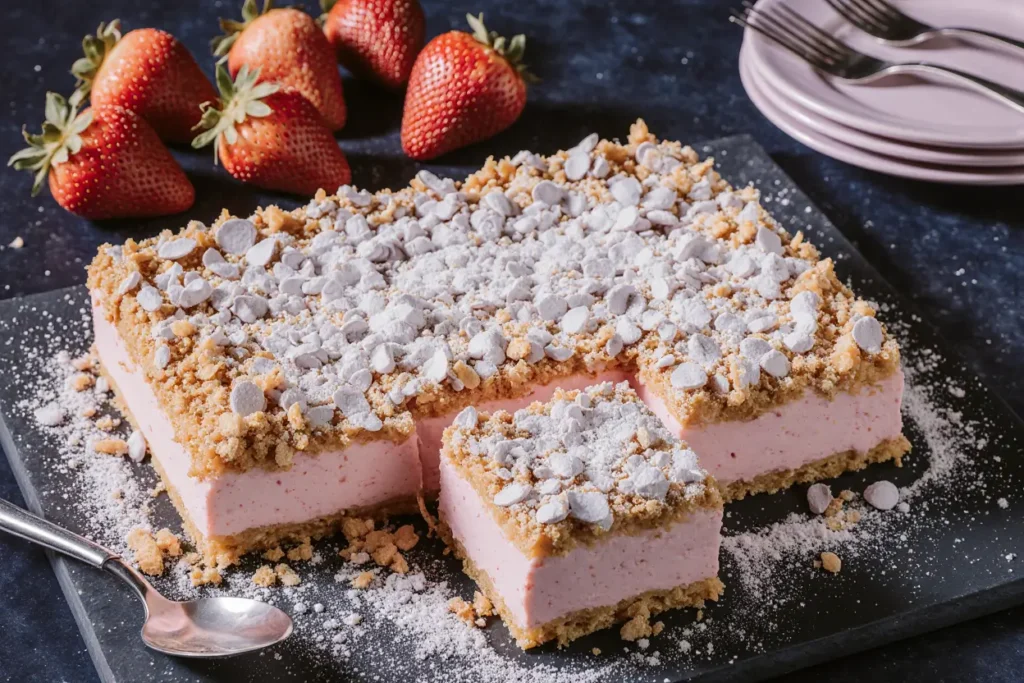
Storing Tips for the Recipe
This dessert maintains optimal quality for up to 4 days when stored in the refrigerator, covered loosely with plastic wrap to prevent moisture absorption while allowing air circulation. The pastry will gradually soften but remains delicious, developing an almost shortbread-like texture.
For advance preparation, bake the complete dessert up to 2 days ahead and store covered. The flavors actually improve as they meld, though the pastry loses some crispness. Bring to room temperature 30 minutes before serving for best texture and flavor release.
Individual components can be prepared separately—strawberry mixture stores well for 24 hours, while cream cheese filling can be made a day ahead and refrigerated. Assemble and bake when ready to serve for optimal results.
Freezing works for up to 1 month when properly wrapped, though the pastry texture changes upon thawing. Thaw overnight in refrigeration and serve chilled rather than attempting to restore original texture through reheating.
Conclusion
Puff Pastry Strawberry Cheesecake represents the perfect marriage of French pastry technique with American dessert sensibility, creating a showstopping finale that’s surprisingly achievable for home bakers. This innovative approach proves that traditional recipes can be reimagined without sacrificing quality or flavor complexity.
The key to success lies in understanding how each component contributes to the final result—the steam-leavened pastry provides textural contrast, while the stabilized filling ensures creamy consistency, and fresh strawberries add natural brightness that prevents the dessert from becoming overly rich.
Ready to revolutionize your dessert game? Gather your ingredients, preheat that oven, and prepare to create a dessert that will have everyone asking for the recipe. Don’t forget to share your beautiful creations—we love seeing how our readers make this stunning dessert their own!
FAQs
Q: Can I use store-bought cheesecake filling to save time? A: While possible, homemade filling provides superior flavor and texture control. Store-bought versions often contain stabilizers that may not interact well with the pastry during baking, potentially affecting the final texture.
Q: What happens if my puff pastry doesn’t rise properly? A: Poor rising usually indicates the pastry was overworked, too warm, or the oven temperature was insufficient. Ensure pastry stays cold during assembly and start with proper oven preheating for maximum steam generation.
Q: Can I make this dessert without a springform pan? A: Yes, use a regular 9-inch pie pan, though removal will be more challenging. Line with parchment paper extending over the edges to create handles for easier lifting after cooling.
Q: How do I know when the cheesecake filling is properly set? A: The center should have a slight jiggle when gently shaken, similar to barely-set gelatin. It will continue cooking from residual heat during cooling. Overbaking creates a rubbery texture.
Q: Can I substitute other fruits for strawberries? A: Absolutely! Raspberries, blueberries, or sliced peaches work beautifully. Adjust sugar content based on fruit sweetness, and consider drainage time for juicier fruits like peaches.
Q: Why did my pastry bottom become soggy? A: Soggy bottoms typically result from excess fruit moisture or underbaking. Ensure strawberries are well-drained and bake until the pastry sounds hollow when tapped gently on the bottom.

